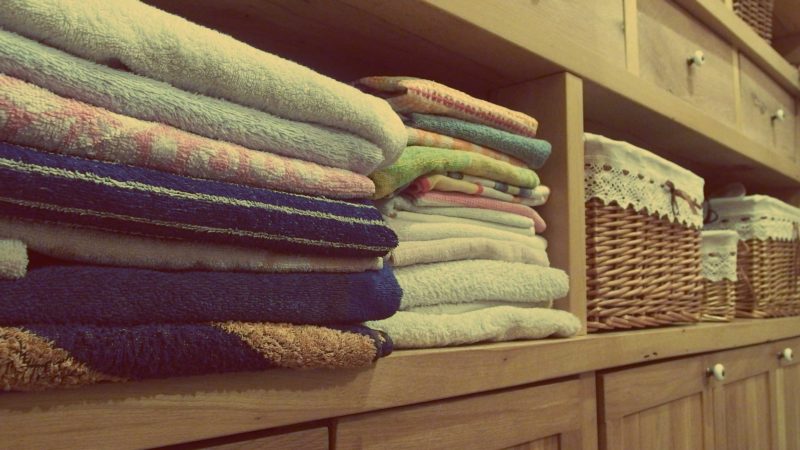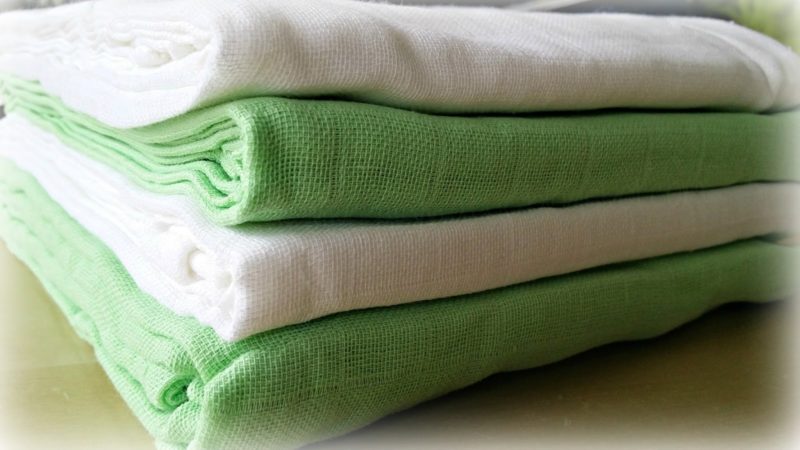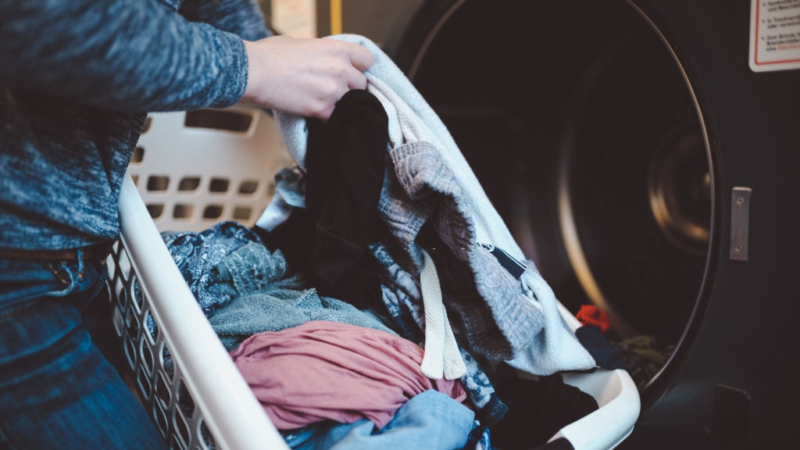The Benefits and How-To’s of Line Drying Indoor Laundry?
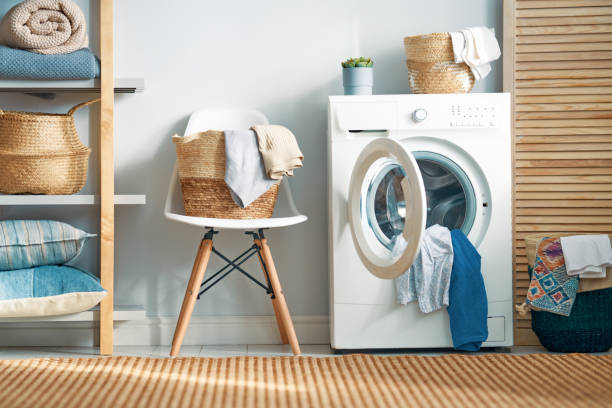
Are you tired of relying on your dryer to get your clothes dry? Did you know that there’s an eco-friendly and cost-effective alternative? Line-drying Indoor Laundry is a great way to save energy and money and reduce your carbon footprint. Moreover, it’s easy to do. In this article, we’ll share some tips for indoor line-drying laundry so you can take advantage of this simple yet effective method. Get ready to learn how to freshen up stale-smelling towels and discover the best places to hang wet clothes in your home. Let’s dive into it:
The Benefits of Line Drying Indoor Laundry
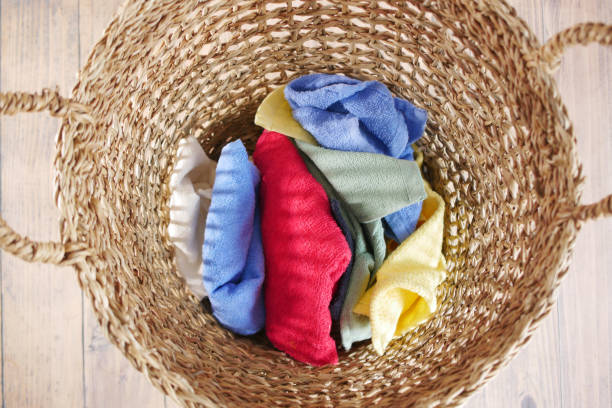
Line-drying Indoor Laundry has many benefits you might not have considered before. First, it’s an eco-friendly way to dry your clothes without using any energy or emitting greenhouse gases from your dryer. This means you’ll reduce your carbon footprint and do your part for the environment.
Another benefit is the cost savings associated with line-drying Indoor Laundry. You won’t need to spend money on electricity to run your dryer, which can add up over time. Moreover, line drying is gentle on fabrics, so they last longer, saving even more money in the long run by reducing wear and tear.
Line drying also helps reduce static cling compared to tumble-drying clothes in a machine. In addition, hanging wet clothes inside can help humidify dry indoor air during cold winter when heating systems create very low humidity levels.
Line drying Indoor Laundry gives you control over how quickly or slowly each garment dries by selecting different locations within your home based on temperature changes throughout the day – this ensures they are all dried at precisely the right moisture level.
Some other quick hacks are:
Saves Energy and Money
Line-drying Indoor Laundry is an excellent way to save energy and money on your electricity bill. You won’t need to use a dryer, one of your home’s most energy-consuming appliances.
Reduces Wear and Tear
Line drying your clothes indoors can reduce the wear and tear caused by a dryer’s high heat and tumbling action. This can extend the life of your clothes, making them last longer.
Environmentally Friendly
Line drying your clothes is an environmentally friendly alternative to a dryer. It reduces your carbon footprint and helps you do your part in protecting the environment.
Freshens Up Clothes
Line drying your clothes indoors can help freshen them up and eliminate stale odours that may be present after washing.
Improves Air Quality
Line drying your clothes indoors can help enhance the air quality by reducing the amount of lint, dust, and other allergens present in a dryer. It can also help prevent mould and mildew buildup in your home.
Safe for Delicate Fabrics
Line drying is a safe option for delicate fabrics such as silk, lace, and cashmere, which can easily shrink, fade or be damaged in a dryer.
No Need for Fabric Softeners
Line drying your clothes can help soften them naturally without needing fabric softeners, which can be expensive and contain harmful chemicals.
Provides Exercise
Hanging your clothes on a drying rack or clothesline can provide light exercise, which can help improve your mood, reduce stress, and increase physical activity.
Makes Clothes Smell Fresh
Line drying your clothes indoors can make them smell fresh and clean without scented dryer sheets or fabric softeners.
Easy to Set Up
Line drying your clothes indoors is easy to set up, requires minimal equipment, and can be done in any room in your home. It’s a convenient and cost-effective way to dry your clothes, especially during colder months or in apartments without outdoor space.
The Best Places to Hang Wet Clothes Inside
When it comes to line-drying Indoor Laundry, choosing the right spot to hang your wet clothes is crucial. Here are some of the best places in your home for air-drying garments.
Consider setting up a drying rack in your bathroom or laundry room. These spaces tend to be humid and well-ventilated, speeding up the drying process. Plus, if water drips from your clothes during drying time, you won’t have to worry about damaging hardwood floors or carpets.
Another great option is balconies or patios that receive plenty of sunlight throughout the day. This setup allows for natural light and ventilation to help dry out damp clothing faster.
If you don’t have access to an outdoor space or a dedicated indoor room for line-drying laundry, look for areas near windows with lots of sunlight and airflow. You could even mount a retractable clothesline across two walls in a spare bedroom or living area.
Regardless of where you hang wet clothes inside, ensure there’s enough space between each item so they don’t touch and cause wrinkles while drying. And always avoid hanging items directly over furniture, as moisture can damage wood surfaces over time.
Tips for Line Drying Indoor Laundry
Regarding line-drying Indoor Laundry, a few tips can make the process more effective and efficient. First and foremost, choose the right spot in your home to hang wet clothes. The ideal location is a well-ventilated area with good air circulation. This will help prevent mould and mildew from forming on your clothing.
Another tip is to use hangers or drying racks to maximize space utilization while minimizing wrinkles. If you need more space, consider investing in collapsible drying racks that can be easily stored away when unused.
To speed up the drying process, use a fan or dehumidifier in the room where you hang your clothes. This will help circulate air and reduce humidity levels, resulting in faster drying times.
If you live in an area with high humidity levels, consider adding some baking soda or vinegar to your wash cycle, as they both work great at removing excess moisture from fabrics.
Refrain from overcrowding your hanging space, as this can lead to longer dry times and wrinkled clothing. Hang items separately so they have plenty of room for airflow around them.
Some quick hacks are:
Choose a Well-Ventilated Area
Choose a well-ventilated area to line dry your Indoor Laundry, such as near an open window, a fan, or a dehumidifier. This will help circulate the air and reduce humidity, allowing your clothes to dry faster and prevent musty odours.
Use a Drying Rack or Clothesline
Use a sturdy and well-ventilated drying rack or clothesline to hang your clothes. Make sure to choose a size that can hold all your clothes without overcrowding them and fit in your home’s available space.
Separate Heavier and Lighter Clothing Items
Separate heavier clothing items from lighter ones to prevent the more severe things from weighing down the lighter ones and causing them to stretch or deform. Hang heavier items, such as jeans, towels, and blankets, on the bottom of the drying rack and lighter items, such as t-shirts, socks, and underwear, on top.
Hang Clothes Properly
Hang clothes properly to prevent wrinkles and allow them to dry evenly. Use hangers for shirts, blouses, dresses, and clothespins or clips for lightweight items like socks and underwear. Avoid hanging clothes too close together, preventing them from drying properly.
Avoid Overloading the Drying Rack or Clothesline
Avoid overloading the drying rack or clothesline, as this can prevent air from circulating and slow down the drying process. Leave enough space between clothes to allow them to move freely and dry faster.
Following these simple tips for line drying Indoor Laundry will save energy costs by avoiding dryer usage while still enjoying fresh-smelling clean clothes.
How to Freshen Up Stale-Smelling Towels?
After line-drying your Indoor Laundry, you may notice your towels have a stale or musty smell. This can be easily remedied with a few simple steps.
Firstly, wash the towels as usual but add half a cup of white vinegar to the rinse cycle. Vinegar is an effective natural deodorizer and will help eliminate any lingering odours.
After washing, avoid using fabric softener or dryer sheets, as they can leave residue on the towels and make them less absorbent.
Next, hang the towels to dry in direct sunlight if possible. The UV rays from the sun will help kill bacteria and freshen up the towel’s fibres.
If sunlight is unavailable, use a fan to circulate air around the room where you are drying your laundry. Good air circulation helps prevent moisture buildup, which can lead to mold growth and unpleasant smells.
If you still notice any lingering odours after washing and drying, try adding baking soda to your next load of laundry. Sprinkle half a cup of baking soda onto your damp towels before starting the wash cycle for an extra boost of freshness.
Some other hacks are:
Wash Towels Properly
Make sure to wash your towels properly to prevent odours from setting in. Use hot water and a good-quality detergent to kill bacteria and remove dirt and sweat. Avoid overloading the washing machine to allow the towels to agitate freely.
Use Vinegar
Vinegar is a natural deodorizer and can help eliminate stale odours from towels. Add half a cup of vinegar to the rinse cycle of your washing machine. Alternatively, soak your towels in a mixture of hot water and vinegar for 30 minutes before washing them.
Use Baking Soda
Baking soda is another natural deodorizer that can help eliminate stale smells from towels. Add half a cup of baking soda to the wash cycle of your washing machine, along with your regular detergent. You can also sprinkle baking soda directly on your towels and let them sit for 30 minutes before washing them.
Dry Towels Properly
Make sure to dry your towels properly to prevent moisture from lingering and causing musty odours. Use the high heat setting on your dryer, or hang your towels outside in the sun to air-dry. Avoid over-drying your towels, making them feel stiff and rough.
Use Essential Oils
Essential oils can add a pleasant scent to your towels and help freshen them up. Add a few drops of lavender, lemon, or eucalyptus essential oil to your rinse cycle or dryer sheets. Alternatively, you can make your own linen spray by combining essential oils with water in a spray bottle.
Following these tips for freshening up stale-smelling towels will ensure that even indoor line-dried laundry feels clean and refreshing and refreshing.
The Drawbacks of Line Drying Indoor Laundry
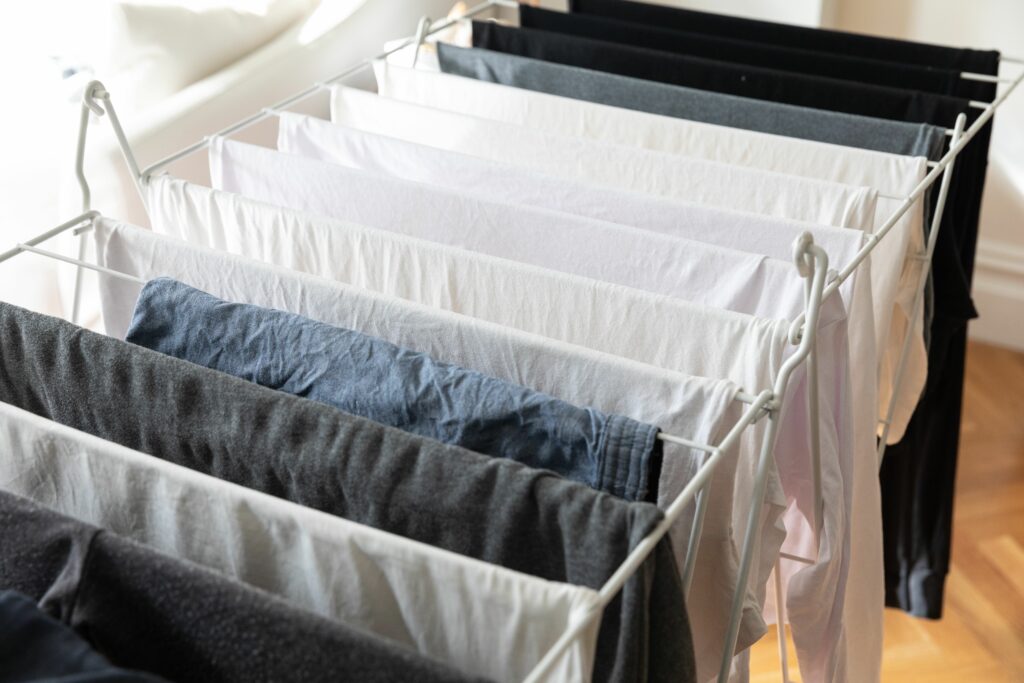
While there are many benefits to line-drying Indoor Laundry, there are also a few drawbacks to keep in mind. One of the most significant issues is space – only some have enough room inside their home to hang clothes on a line, especially if they have a large family or live in a small apartment.
Another drawback is that clothes can take longer to dry indoors than outside, especially if you need better ventilation or airflow. This can be frustrating if you need your clothes dried quickly.
Line drying indoors can also increase humidity levels and mould growth if the area isn’t properly ventilated. This can be particularly problematic for those with allergies or respiratory issues.
Additionally, certain fabrics may need to do better when hung up wet, such as wool, which easily stretches out of shape, and heavy materials like denim, which may take too long to dry when hung up damp.
While there are some downsides associated with Indoor Laundry drying, it’s still an excellent way of saving energy and money on electricity bills that come with using electric dryers. Being mindful of these challenges and taking steps like using fans and opening windows during the process will help avoid any unpleasant surprises along the way.
Why Should You Line-Dry Clothing?
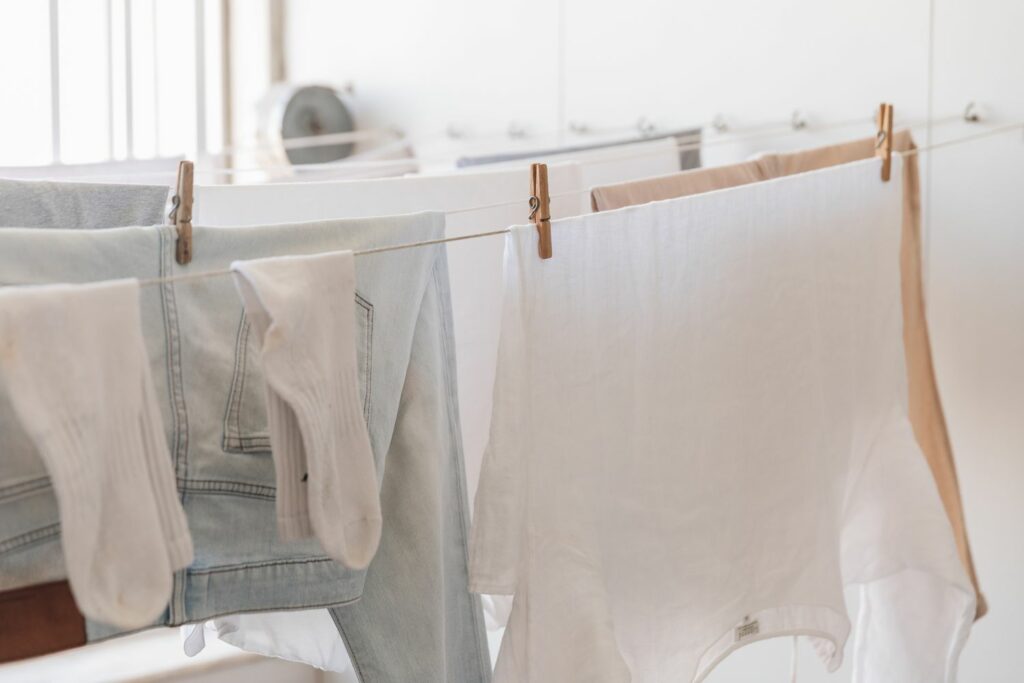
There are several reasons why you should consider line-drying your clothing indoors. First and foremost, it’s an eco-friendly way to dry clothes as it doesn’t require any electricity or gas usage. This means you’ll reduce your carbon footprint while saving money on utility bills.
Secondly, line drying your clothes can help preserve their quality over time. When clothes are tumble-dried, they’re subjected to high temperatures, which can cause shrinkage and damage to the fibres in the fabric. Line drying is a gentler process that helps prolong the life of your garments.
Additionally, line drying eliminates static cling that often occurs during machine drying. This makes ironing easier and quicker since the items won’t be stuck together with static.
Furthermore, hanging Indoor Laundry can add moisture to the air, benefiting those who suffer from dry skin or allergies caused by dry air. Adding humidity can also make indoor living spaces more comfortable during winter when heaters tend to create overly dry conditions.
There are many benefits to line-drying your Indoor Laundry – from cost-saving advantages to improving garment longevity and indoor air quality – making it a great option for anyone looking for a more sustainable way of doing laundry.
How Often to Line Dry Indoor Laundry?
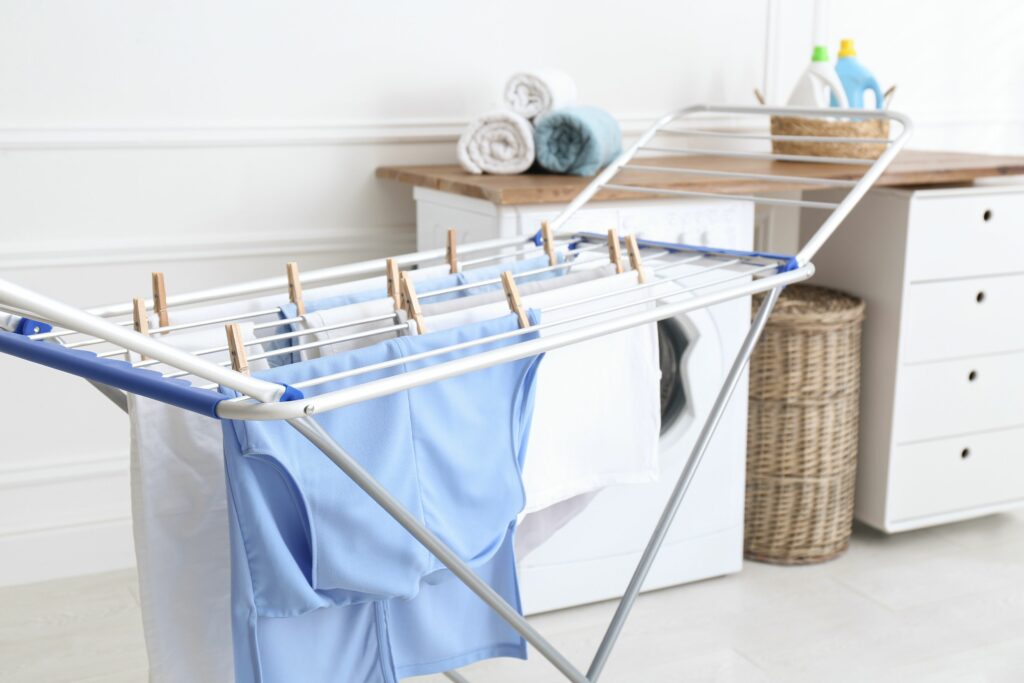
When it comes to how often you should line dry your Indoor Laundry, the answer depends on various factors. Firstly, the weather plays a significant role in determining how often you can hang your clothes inside. If there’s high humidity or rain outside, you may need to hang your Indoor Laundry more frequently.
Another factor that influences how often you line dry clothing indoors is the size of your family and washing frequency. For instance, if you have a large family and do multiple loads of laundry daily, hanging clothes inside every day might be necessary.
However, if you live alone or with just one other person and do not produce as much washing per week, then once or twice a week suffice for indoor drying. Additionally, some fabrics require more care than others – items like delicates may need to be hung up after every wash cycle.
Ultimately, the choice of whether to air-dry clothing outside or inside will depend on individual preference and circumstances such as location or environmental concerns (e.g., allergies).
What You’ll Need in Line Drying Indoor Laundry?
When it comes to line-drying Indoor Laundry, there are a few key things you’ll need to make the process go smoothly. First and foremost, you’ll need a space in your home to hang your clothes up to dry. This could be a spare room or a corner of your living area.
Next, you’ll want to invest in quality drying racks or clotheslines. Many options are available on the market today, from foldable stands that can be stored away when not in use to retractable lines that can be mounted on walls or ceilings.
Consider using hangers for items like shirts and dresses that need more support while drying. Additionally, having some clips or clothespins on hand will be handy when hanging smaller items like socks and underwear.
Some quick hacks:
Line-drying Indoor Laundry is a convenient and energy-efficient way to save money on your electricity bill. Here are some items you’ll need to make the process go smoothly:
Drying Rack
A drying rack is a must-have for line-drying clothes indoors. You can choose from different sizes and types, such as collapsible, wall-mounted, or freestanding. Choose a sturdy and well-ventilated rack that can hold all your clothes without tipping over.
Hangers
Hangers are helpful for hanging up shirts, blouses, dresses, and other clothing items that can’t be folded. They can help clothes dry faster and reduce wrinkles.
Clothespins or Clips
Clothespins or clips are handy for securing lightweight clothing items, such as socks, underwear, and towels, to the drying rack or clothesline. Choose durable and rust-resistant clothespins or clips that won’t leave marks on your clothes.
Laundry Bag or Basket
A laundry bag or basket can help you transport your wet clothes from the washing machine to the drying rack or clothesline. Make sure to choose a bag or basket large enough to hold all your clothes without overcrowding them.
Fabric Softener or Dryer Sheets
Using fabric softener or dryer sheets can help reduce static and make your clothes smell fresh. They can also help clothes dry faster and reduce wrinkles.
Fan or Dehumidifier
A fan or dehumidifier can help circulate air and reduce humidity in the room, making your clothes dry faster. Make sure to choose a fan or dehumidifier with adjustable settings that can accommodate different temperatures and humidity levels.
With these items on hand, you’ll be well-prepared to line-dry your Indoor Laundry and save money on your energy bill.
In terms of materials, you will only need what’s already included in your clothing. However, if you’re concerned about dampness or musty smells developing during drying, adding some essential oils or fabric softener sheets into the mix could help freshen things up.
The tools and materials needed for indoor line-drying are relatively easy to acquire – making it an affordable alternative to running energy-hogging dryer cycles day after day.
How to Line Dry Clothing Indoor Laundry?
When it comes to line-drying Indoor Laundry, there are several steps you can take to ensure that your clothes dry efficiently and effectively. First, choose a well-ventilated area where air can circulate around the clothing items. This could be near an open window or a room with a ceiling fan.
Next, hang each item of clothing separately on hangers or a drying rack. Avoid overcrowding the space, as this will prevent proper airflow and slow drying.
Consider using two hangers for added support if you’re dealing with particularly heavy or thick items like towels or jeans. Be sure to shake out each item before hanging it up – this will help remove any wrinkles and speed up the drying time.
For best results, keep your Indoor Laundry drying area away from high-humidity areas like bathrooms and kitchens, which may cause moisture buildup on your clothes.
Line-drying clothing indoors is an eco-friendly alternative that saves energy costs while extending the life of your garments. With these simple tips in mind, you’ll be able to enjoy fresh-smelling laundry without ever having to step outside.
Some Quick Hacks:
Here are some quick hacks for line-drying clothing indoors:
- Hang clothes on hangers to avoid wrinkling and save space
- Use a fan to circulate air and speed up drying time
- Place a towel or cloth underneath clothes to absorb excess moisture
- Hang clothes in a bathroom with an open window or ventilation fan to reduce humidity
- Hang clothes on a clothesline or drying rack near a sunny window to take advantage of natural heat and light
- Use a fabric softener or dryer sheet to reduce static and make clothes smell fresh
- Shake clothes out before hanging to reduce wrinkles and speed up drying time
- Hang heavy items like towels and jeans at the bottom of the drying rack or clothesline to prevent them from toppling.
- Hang delicates or items prone to stretching on a mesh drying rack or flat surface.
- Use a spray bottle to mist clothes with water and speed up drying time.
Some FAQs
Is it OK to dry clothes indoors?
Answer: Yes, it is safe to dry clothes indoors. However, it is essential to ensure proper ventilation to prevent moisture buildup, which can lead to mould growth and other problems.
How do you hang Indoor Laundry?
Answer: You can hang Indoor Laundry using a drying rack, clothesline, or hangers. Choose a well-ventilated area to avoid dampness, and make sure the clothes are not too close to each other.
Which drying clothes indoors?
Answer: Drying clothes indoors is suitable for any clothing, but it is handy for delicate items that may shrink or get damaged in a dryer.
How do you dry clothes indoors without them smelling?
Answer: To prevent clothes from smelling bad after drying indoors, ensure the area is well-ventilated, and consider using natural air fresheners like essential oils or vinegar. Add baking soda to the washing cycle or use a fabric softener to eliminate odours.
Why do clothes smell bad after drying indoors?
Answer: Clothes can smell bad after drying indoors due to moisture buildup, lack of proper ventilation, or using too much detergent. It can also be caused by improper drying of clothes, leading to mildew or mould growth.
Why do my husband’s clothes smell after washing?
Answer: Your husband’s clothes may smell bad after washing due to excessive sweat or body odour, not using enough detergent, or not washing the clothes totally.
How can I make my laundry smell good naturally?
Answer: You can naturally make your laundry smell good by using essential oils, vinegar, or baking soda. Adding a few drops of your favourite essential oil to the wash cycle or using a cup of vinegar in the rinse cycle can help eliminate odours and leave your clothes smelling fresh.
Is it normal to smell my boyfriend’s clothes?
Answer: It is common to smell your boyfriend’s clothes, as the scent can be comforting and familiar. However, it is essential to respect your partner’s privacy and limitations.
What’s the best-smelling laundry detergent?
Answer: The best-smelling laundry detergent can vary depending on personal preference. Some popular options include Tide, Gain, and Downy.
How can I make my clothes smell good all day?
Answer: You can make your clothes smell good all day by using a long-lasting fabric freshener or adding a few drops of essential oil to a sachet or dryer sheet. You can also consider wearing clothing made from natural fibres that are less likely to retain odours.
Is laundry powder or liquid better?
Answer: Laundry powder and liquid detergent are equally effective in cleaning clothes, but powder detergent may be more cost-effective and eco-friendly.
Do hotels use laundry detergent?
Answer: Yes, hotels use laundry detergent to wash linens and towels. However, they may use commercial-grade detergents that are more effective in removing stains and odours.
Conclusion
In conclusion, line-drying Indoor Laundry is a cost-effective, environmentally friendly, and suitable option for drying your clothes. It provides numerous benefits, such as reducing wear and tear on clothes, improving air quality, and freshening up stale odours. With simple tips and tricks, you can easily set up an indoor drying space and enjoy the benefits of line-drying your Indoor Laundry. Moreover, you’ll save money on your electricity bill and help reduce your carbon footprint.



